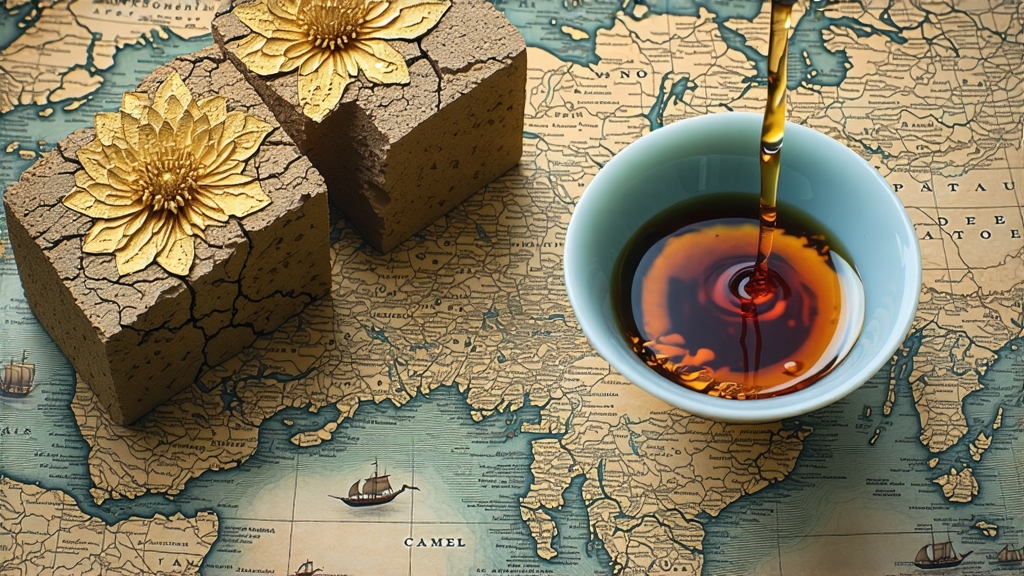
Few teas carry the dust of the ancient Silk Road in every leaf as vividly as Fu brick tea. Pressed into dense black rectangles, this sub-category of Chinese dark tea (hei cha) was born in the 1360s in Jingyang County, Shaanxi, yet its fame quickly radiated westward, supplying caravans that bartered it for Central-Asian horses, wool and even spices. Traders valued its ability to travel for months without spoiling, discovering that the bricks actually improved in aroma and medicinal sweetness the farther they moved from home. Today, Fu brick remains the only tea intentionally inoculated with a Eurotium cristatum mould that blooms into visible, ochre “golden flowers” (jin hua) during a month-long, closely monitored wet-piling phase. Those flowers, looking like tiny specks of pollen, are the living signature of the tea and the key to its mellow, dried-jujube liquor that never bites, even after a dozen infusions.
1. Historical footprint
The name “Fu” derives from the old government trade office “Fu Cha Si” that supervised tea-for-horse exchanges during the Ming dynasty. Regulations fixed the brick weight at five “jin” (about 2.5 kg) and stamped each piece with an iron-brand seal guaranteeing purity. Because the route crossed arid plateaus, camel drivers learned to boil shavings of the brick with yak butter and salt, creating the prototype of Tibetan butter tea. By the Qing era, Hunan’s Anhua County had become the main leaf supplier; its large-leaf cultivars offered the robust body needed to survive the humid piling process. Caravans departing Xi’an carried up to 3,000 Fu bricks per train, and imperial records credit the beverage with curbing rancidity in dairy and preventing altitude sickness among soldiers.
2. Terroir and leaf grades
Authentic Fu bricks now enjoy national geographical-indication status limited to three zones:
- Shaanxi Jingyang: loess plateau with alkaline groundwater that buffers pH during fermentation.
- Hunan Anhua: granite mountains, morning fog and bamboo forests that cool the leaf piles.
- Zhejiang Songyang: a newer micro-zone experimenting with small 200 g “mini bricks” for urban markets.
Only one-pick-one-leaf or one-pick-two-leaf standards plucked before the Grain-Rain solar term are accepted; larger blades would trap excessive heat, while earlier buds lack the polyphenols required for golden-flower propagation.
3. Crafting the golden flowers
Unlike shou Pu-er that relies on general microbial consortia, Fu brick production is a choreographed dance with a single fungus. After withering, fixing and primary rolling, the maocha is re-hydrated to 28 % moisture, heaped 70 cm deep inside underground cellars lined with pine boards. Temperature probes keep the core between 45 °C and 55 °C for 20–25 days; any hotter kills the desired spores, any cooler invites toxic moulds. Workers “flip” the pile every four days, spraying tiny amounts of the previous batch’s golden-flower powder to seed new growth. When the leaf surface reaches 80 % ochre coverage, the tea is steam-softened and hydraulic-pressed into bricks under 50 t of pressure. A final 7-day “flowering rest” in ventilated racks allows the fungus to penetrate 2–3 mm inward, after which the bricks are dried at 37 °C until moisture drops below 9 %.
4. Aging alchemy
Although drinkable immediately, Fu brick enters a second life in storage. Enzymes from Eurotium cristatum continue converting cellulose into soluble sugars and coupling amino acids with catechins to form novel pigments that round off astringency. After three years the liquor turns from tawny to deep claret, and a camphor-cool note appears. Connoisseurs compare a 15-year brick to aged Bordeaux: the same graphite, dried fig and wet earth complexity, yet with zero tannic pucker. The optimum aging corridor is 60 % relative humidity and 20–28 °C; below 50 % the flowers desiccate, above 70 % dangerous yellow mould may bloom.
5. Decompression and brewing ritual
Because the brick is compressed to 1.1 g cm⁻3, prying it demands patience. Insert a thin tea needle along the natural vein, levering off 5–7 g flakes rather